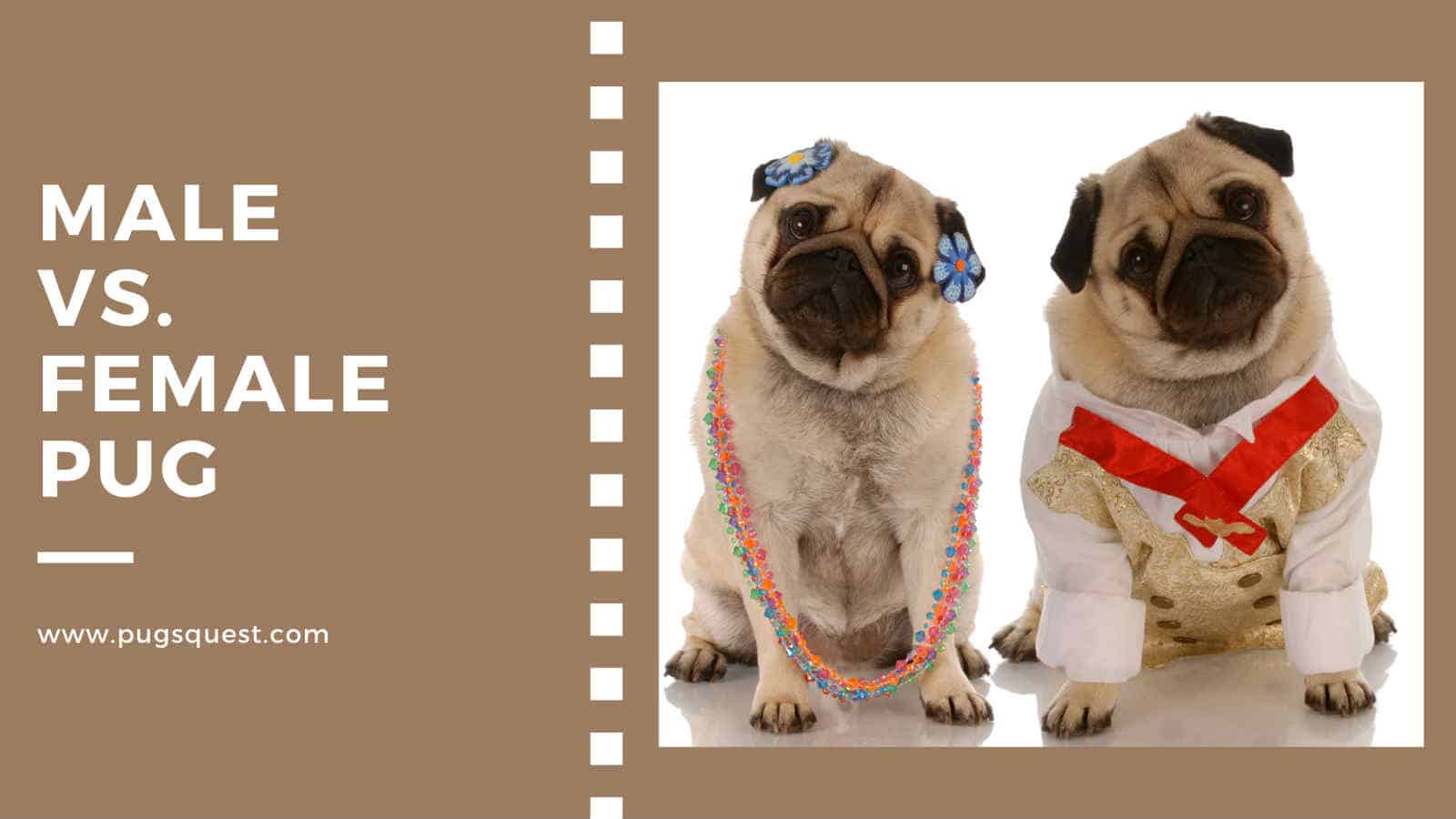
Finding a pet that fits with your unique lifestyle can be a challenge. Trust me, I know how you feel. Before getting my Pug, I ummed and ahhed like there’s no tomorrow.
But don’t worry. We’re giving you the gift of experience with this go-to guide to male vs. female Pugs.
Which will you choose?
Male vs. Female Pugs: Is There A Difference?
The short answer is yes.
Before getting a Pug of your own, we recommend thinking carefully about the characteristics you wish for in a dog. This will help you decide whether a male or female Pug is best for you.
But before we delve into the details, here’s a brief overview of the main differences. Remember that every Pug has its own unique temperament irrespective of gender.
- Female Pugs are (generally) smarter and easier to train
- Male Pugs can suffer from a short attention span
- Female Pugs are more dominant and motherly
- Male Pugs are more laid back and sociable
- Spaying (female) is more expensive than neutering
- Female Pugs often live longer than male Pugs
Ready to learn more?
We’ve compiled a comprehensive guide that covers all the major differences between male and female Pugs from appearance to health and temperament.
So, what are we waiting for?
Male & Female Pugs: Physical Appearance Difference
The physical differences between male and female Pugs are marginal. It can sometimes be impossible to tell whether a Pug is male or female based on physical appearance alone.
That’s because there isn’t a massive difference in their stature or physical characteristics. But if you look closely, there are some tell-tale signs.
In general, male Pugs are slightly taller and heavier than females, with a greater muscle mass. That’s why some male Pugs appear on the stockier side than their female counterparts.
Overview
| Male Pug | Female Pug |
| Height: 10-14 inches | Height: 10- 12 inches |
| Weight: 20-30 lbs | Weight: 13-18 lbs |
| Appearance: stocky build with more muscle mass | Appearance: usually slimmer with less muscle mass |
Male vs. Female Pug Temperaments
Though there are some common differences when it comes to male vs. female Pug temperaments, it’s also a game of chance.
Every Pug will have his or her unique set of traits. That’s what makes them unique.
Their living environment and training will also have a significant bearing on your Pug’s temperament. In other words, it’s not all about gender.
The Pug breed is known for being incredibly loving and docile. That’s what makes them such wonderful companions and pets.
But let’s take a look at some of the most recognizable differences between male and female Pug personalities.
In general, male Pugs tend towards mischief.
Just like parents of teenage boys, some Pug owners have reported that their adolescent male Pugs (6 months- 3 years) go through a ‘defiant’ phase.
But aside from this, males are more often than not, laid back and playful.
A recipe for endless laughs.
Female Pugs tend towards shyness.
Both males and females are loving and affectionate, great with families, children and other animals.
The female Pug’s mothering nature means that they are expert sofa snugglers but they might hold back their affections from time to time.
But this maternal instinct also makes female Pugs super protective.
They may be quicker to snap or nip than males and more emotionally volatile, especially in their younger years.
At the end of the day, male or female, Pugs are softies. They’ll want to be your best friend and please you beyond measure. But watch out for that stubborn streak. Both males and females are divas through and through.
Overview
| Male Pug | Female Pug |
| Mischievous | Shy |
| Playful and energetic | Less attention seeking/ clingy |
| Attention seeking/ clingy | More protective |
Intelligence & Trainability
Female Pugs are smarter than their male counterparts. Because of this, they are generally considered easier to train. However, that’s not to say that training a male Pug is impossible.
Most Pugs will adjust to training with time and patience. They might just require different methods along the way.
Due to their intellect, female Pugs are better able to focus on training. Their more reserved nature means that they are more motivated by instructions. They want to please their owners by obeying their commands.
Male Pugs, on the other hand, have a shorter attention span and insatiable desire for playtime. But this need not spell a training disaster. Males are also easier to distract.
Because of their intellectual differences male and female Pugs respond to different training methods.
For females, off-leash training is ideal. Your female Pug is unlikely to get too distracted. Just be vigilant when around strangers or other animals. She may become nervous.
For males, expect some loss of focus (especially when they are still young). It’s best to train a male Pug on the leash to prevent them from leaping at squirrels here and there.
But remember, your male Pug is highly motivated to please you. Use positive reinforcement and commend them for good behaviors.
Overview
| Male Pug | Female Pug |
| Distractible | More intelligent |
| Loss of focus | Focussed |
| On-leash training | Off-leash training |
| Positive reinforcement | May be nervous |
Lifespan and Health
Male Pugs have a slightly shorter average life expectancy than females. Male Pugs average 12.8 years and females, in comparison, average 13.2 years. But, irrespective of gender, Pugs can be expected to live between 12-15 years.
At the end of the day, a Pug’s lifespan has more to do with health, environment, and genetics than it does gender.
The best way to boost longevity is with the care you give them. That means healthy nutrition, exercise, top-notch hygiene, and regular health checks.
This is where gender comes into the equation.
Male and female Pugs each have their own, unique, healthcare requirements.
All Pugs have a predisposition to certain health conditions. The most common ones are respiratory distress, bone deformities, eye problems and allergies. This is largely due to their genetic makeup and is not caused by gender.
However, a Pugs reproductive health must also be taken into account. By 12 months, most Pugs will be reaching, or have reached sexual maturity.
Unless you plan on breeding your Pug, females should be spayed, and males neutered to prevent a potentially fatal ovarian or testicular cancer and moderate behavior.
Male & Female Pug: Spaying And Neutering
1. Spay Female Pugs
Spaying your female Pug usually costs in the region of $50-$250. The procedure is carried out when your Pug is approximately 8-weeks old.
Spaying will stop your Pug from going into heat and having her period. Heat usually lasts around 3 days, twice a year.
During this time an unspayed female will attract lots of male attention, produce discharge, shed more than usual, and she may even become flighty and try to escape.
Spaying is the best way to prevent these behaviors but, most importantly, prevent the development of ovarian or breast cancer.
2. Neuter Male Pugs
Neutering your male Pug usually costs in the region of $45-$135 and is carried out at the 12-15 month mark.
Many Pug owners don’t like the idea of neutering their males. It’s often thought of as emasculating, or simply unnecessary.
After all, there’s no risk of them getting pregnant, right?
But neutering your Pug is about more than preventing puppies. It prevents testicular cancer, prostate enlargement, and reduces unruly behaviors.
Female dogs in heat give off pheromones that male dogs can smell from miles and miles away. A male Pug that is not neutered will mark their territory with urine and try to hump every lady Pug that crosses their path.
Male or Female Pug: Which is Right For You?
When it comes to male vs. female Pugs, irrespective of gender, these are loving and affectionate companion animals.
But there are some differences that prospective owners will want to consider.
If you’re looking for brains opt for a lady Pug, but if you want to bring home the most sociable kid on the block a male Pug might be the one for you.
